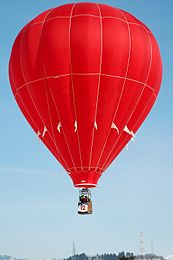General aviation
General aviation (GA) is defined by the
General aviation thus represents the "private transport" and recreational components of aviation.[3]
Definition

The International Civil Aviation Organization (ICAO) defines civil aviation aircraft operations in three categories: General Aviation (GA), Aerial Work (AW) and Commercial Air Transport (CAT).[1][3] Aerial work operations are separated from general aviation by ICAO by this definition. Aerial work is when an aircraft is used for specialized services such as agriculture, construction, photography, surveying, observation and patrol, search and rescue, and aerial advertisement. However, for statistical purposes ICAO includes aerial work within general aviation, and has proposed officially extending the definition of general aviation to include aerial work, to reflect common usage.[2][1] The proposed ICAO classification includes instructional flying as part of general aviation (non-aerial-work).
The International Council of Aircraft Owner and Pilot Associations (IAOPA) refers to the category as general aviation/aerial work (GA/AW) to avoid ambiguity. Their definition of general aviation includes:[3]
- Corporate aviation: company own-use flight operations
- Fractional ownership operations: aircraft operated by a specialized company on behalf of two or more co-owners
- Business aviation (or travel): self-flown for business purposes
- Personal/private travel: travel for personal reasons/personal transport
- Air tourism: self-flown incoming/outgoing tourism
- Recreational flying: powered/powerless leisure flying activities
- Air sports: aerobatics, air races, competitions, rallies, etc.[3]
General aviation thus includes both commercial and non-commercial activities.
IAOPA's definition of aerial work includes, but is not limited to:[3]
- Agricultural flights, including crop dusting
- Banner towing
- Aerial firefighting
- Medical evacuation
- Pilot training
- Search and rescue
- Sight seeingflights
- Skydivingflights
- Organ transplanttransport flights
Commercial air transport includes:
- Scheduled air services
- Non-scheduled air transport
- Air cargo services
- Air taxi operations
However, in some countries, air taxi is regarded as being part of GA/AW.
Private flights are made in a wide variety of aircraft:
The majority of the world's air traffic falls into the category of general aviation, and most of the world's airports serve GA exclusively.[3] Flying clubs are considered a part of general aviation.
Geography
Europe
In 2003, the
United Kingdom
Of the 21,000 civil aircraft registered in the United Kingdom,
GA is regulated by the
North America
General aviation is particularly popular in North America, with over 6,300 airports available for public use by pilots of general aviation aircraft (around 5,200 airports in the
Regulation
Most countries have a civil aviation authority that oversees all civil aviation, including general aviation, adhering to the standardized codes of the International Civil Aviation Organization (ICAO).
Safety
Aviation accident rate statistics are necessarily estimates. According to the U.S. National Transportation Safety Board, general aviation in the United States (excluding charter) suffered 1.31 fatal accidents for every 100,000 hours of flying in 2005, compared to 0.016 for scheduled airline flights.[9] In Canada, recreational flying accounted for 0.7 fatal accidents for every 1000 aircraft, while air taxi accounted for 1.1 fatal accidents for every 100,000 hours.[10] More experienced GA pilots appear generally safer, although the relationship between flight hours, accident frequency, and accident rates are complex and often difficult to assess.[11][12][13]
A small number of commercial aviation accidents in the United States have involved collisions with general aviation flights, notably
See also
- Commercial aviation
- Environmental impact of aviation
- General Aviation Revitalization Act of 1994
- List of current production certified light aircraft
- List of very light jets
- OpenAirplane (defunct web-based service)
- One Six Right (2005 documentary)
- Private aviation
- Small Airplane Revitalization Act of 2013
- Associations
- Aircraft Owners and Pilots Association
- Canadian Owners and Pilots Association
- Experimental Aircraft Association
- General Aviation Manufacturers Association
- National Business Aviation Association
References
- ^ ISBN 9789292315368. Archived(PDF) from the original on 12 January 2015. Retrieved 17 March 2019.
- ^ a b "ICAO web site" (PDF). Archived (PDF) from the original on 9 February 2015. Retrieved 17 June 2020.
- ^ a b c d e f g "What is General Aviation; Definition". The International Council of Aircraft Owner and Pilot Associations (IAOPA). Retrieved 16 March 2019.
- ^ "5" (PDF). Strategic Review of General Aviation in the UK. CAA. July 2006. pp. 52–53, paras. 5.18–5.24. Archived (PDF) from the original on 21 December 2016. Retrieved 19 December 2016.
- ^ "UK Registered Aircraft January 2010" (PDF). CAA. Archived from the original (PDF) on 25 May 2017. Retrieved 19 December 2016.
- ^ Nav Canada: Canada Flight Supplement - Canada and North Atlantic Terminal and Enroute Data Nav Canada, 2010.
- ^ FAA Administrator's Fact Book (PDF). U.S. Department of Transportation. March 2010. p. 16. Archived (PDF) from the original on 19 February 2009.
- ^ AOPA USA's General Aviation website Archived 14 February 2015 at the Wayback Machine.
- ^ "NTSB accident rates by flying category" (PDF). Ntsb.gov. Archived (PDF) from the original on 5 September 2015. Retrieved 19 December 2016.
- ^ "Aviation Safety Program Manual for the Civil Aviation Directorate". Tc.gc.ca. 31 December 2015. Retrieved 19 December 2016.
- ^ Knecht, WR (2012). DOT/FAA/AM-12/15 "Predicting general aviation accident frequency from pilot total flight hours" (Technical Report). Archived 19 November 2012 at the Wayback Machine. Washington, D.C.: Federal Aviation Administration.
- ^ Knecht, WR (2015). "The 'killing zone' revisited: Serial nonlinearities predict general aviation accident rates from pilot total flight hours". Accident Analysis & Prevention, 60, 50–56.
- ^ Knecht, WR (2015). DOT/FAA/AM-15/3 "Predicting accident rates from general aviation pilot total flight hours" (Technical Report). Archived 19 November 2012 at the Wayback Machine. Washington, D.C.: Federal Aviation Administration.


